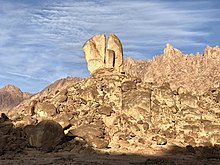Rephidim
This article uses secondary sources that critically analyze them. (October 2022) ) |

Rephidim or Refidim (Hebrew: רְפִידִים) is one of the places visited by the Israelites in the biblical account of the Exodus from Egypt.

Biblical account
This episode is described in the
Afterwards, the Amalekites attack the Israelites encamped at Rephidim, but are defeated. The Israelites are led in the battle by Joshua, while Moses, Aaron and Hur watch from a nearby hill. Moses notices that when his arms are raised the Israelites gained the upper hand, but when they are down the Amalekites prevail. He sits with his hands held up by Aaron and Hur until sunset, securing the Israelite victory.[3] The image of Moses raising his arms in battle against Amalek has been seen by allegorical Christian commenters as a prefiguration of Jesus's arms extended on the cross battling sin.[4]
Location
One proposal places Rephidim in the

Another proposed location for Rephidim is in northwestern Saudi Arabia north of the town of
More recent scholarship identifies Rephidim with Wadi Refayid in the southwest Sinai.[8][9]
References
- ^ Exodus 17:1–7
- ISBN 978-0-674-03008-4.
- ^ Exodus 17:8–16
- ISSN 2391-7598. Retrieved 18 November 2021.
Origen certainly sees Jesus crucified in the image of Moses lifting his hands, while he also notes the difference – Jesus is not simply another Moses.
- ^ a b James K. Hoffmeier, Ancient Israel in Sinai (Oxford University Press, 2005) page 169.
- ^ Exodus 19:1-2; Numbers 33:14-15
- ^ "The Split Rock And Battlefield At Rephidim". Jabal Maqla. 2019-05-22. Retrieved 2019-05-28.
- Walter C. Kaiser, History of Israel, p. 116
- ISBN 978-1-4674-6046-0.
Tradition has long identified Wadi Feiran near Jebul Musa as the location of Rephidim, although more recent scholarship prefers the nearby Wadi Refayid because of the similarity in name.
